

Princess of Vines, Karen Crouse ---->
Precision Farmed by Pulido Vineyard Management
Crouse Vineyards Dash- Soil Moisture, Temp and Irrigation System Trends, Tank Level, Pumping Events
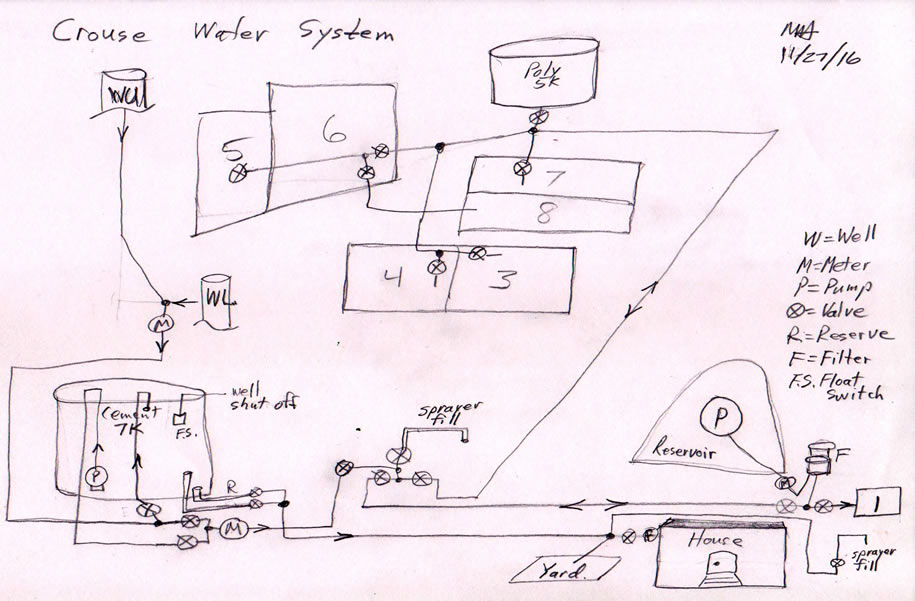
2014/2015 Yield Summary
Buyer/Blocks |
Blk.# |
Acres |
Tonnage 2014 Act. |
Tonnage 2015 Act. |
|
|
|
|
|
Crouse MVMV Cab.Sauv. |
3,4,6 |
|
11.272 |
1.27+1.0 +3.4 = 5.7 |
Crouse MVMV Merlot |
8 |
|
1.859 |
1.34 |
Kugler Dumaine Cab |
5cab |
|
1.7685 |
1.6 |
Kugler Toulouse Merlot |
5M |
|
1.755 |
1.4 |
Criste Merlot |
8 |
|
1.055 |
0 |
Criste Cab. Sauv. |
7 |
|
1.178 |
.56 |
Total Cab.Sauv |
|
0.00 |
14.2185 |
7.8 |
Total Merlot |
|
|
4.669 |
2.7 |
Total Both Cab and Merlot* |
|
7.2 |
18.8875 |
10.5 |
Bacchus |
1 |
5.4 |
4.4 |
5.5 |
Percentage Cab |
|
|
75% |
74% |
Percentage Merlot |
|
|
25% |
26% |
|
|
tons/acre |
lbs/vine |
tons/acre |
Overall Yield |
|
2.623* |
3.958* |
1.45* |
* Not including Bacchus.
2015 Forecast and Plan
2014 yields were down slightly from 2013 but, prices were up yielding a little extra income in 2014. The plan for 2015 is to repeat 2014 with slightly higher yields due to extention of cordons and refinements in the Bacchus block including active farming of the upper half of Bacchus. We are expecting significant gains in yield in Bacchus, up by 50% especially if the addition of the reservoir leak recovery system works and we have irrigation water for Bacchus. Here's a table listing the fruit available for sale.
Update: 8/30/15, The weather at bloom didn't see fit to support our yield plan and reduced the fruitset by 30-50%. Ms. Crouse decided to sell fewer grapes to insure her winemaking program is fully supplied.
2014 Forecast and Plan
The Majority of the grapes are used in house by Mount Veeder Magic Vineyards. Before the start of the 2013 growing season vineyard management was changed to Pulido Vineyard Management and as a result yields have increased providing additional fruit for sale in the open market. Approximately 8 tons of fruit was sold in 2013 with about 10 tons available in 2014 even after an increase in in-house use of the grapes from 11 tons to 14 tons; 12.3T Cab, 1.7T Merlot.
Our estimate as of 4/9/14 is that we will see a 10% increase in yield this year to 21 tons +/- 20% and will see block 1L yield significantly for the first time providing another 3.1-6 tons of Cabernet Sauvignon. Ms. Crouse has increased her in house production needs by 25% to 14 tons nominally. This leaves 7 tons plus the fruit from 1L, conservatively 3.1 tons, to be sold.
The following fruit is available for sale in 2014: Cabernet Sauvignon: 6.6 Tons, Merlot 3.5 Tons
PetioleAnalysis 0514 taken a little before bloom 5/16/14. This shows that we are slightly low in Boron and Zinc in block Royal which has been addressed with foliar spray in conjunction with our Powdery Mildew program. It also shows that we have been successful in getting the nitrogen levels up in the lower half of the Bacchus block.
See below for maps.



Below is a map that includes block 1 on the left, the long rectangular block. The upper(northern) half of this block is Block 1L. Eventually I'll figure out how to highlight it.


Drone photos taken in July /2014

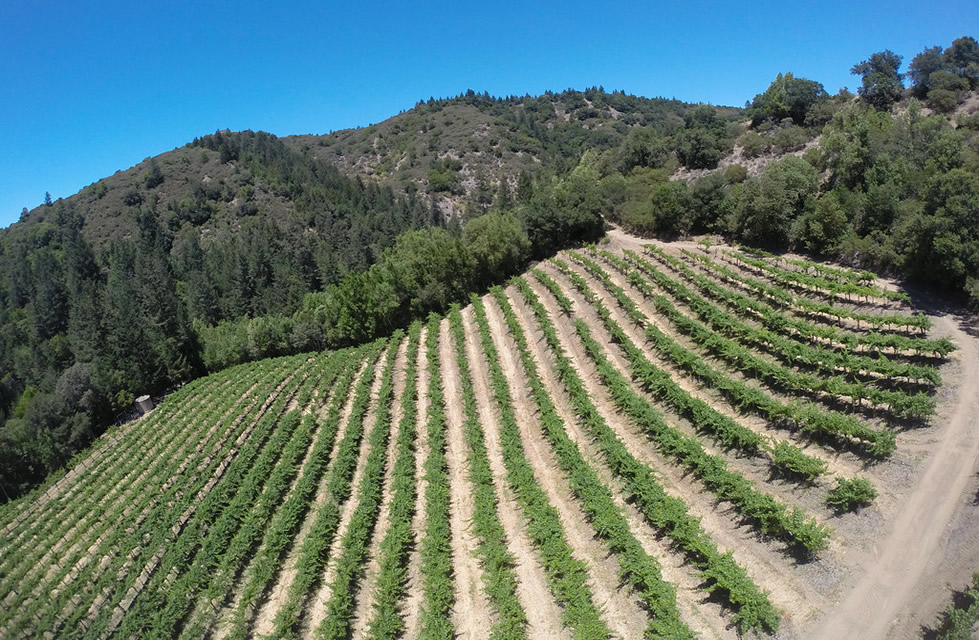
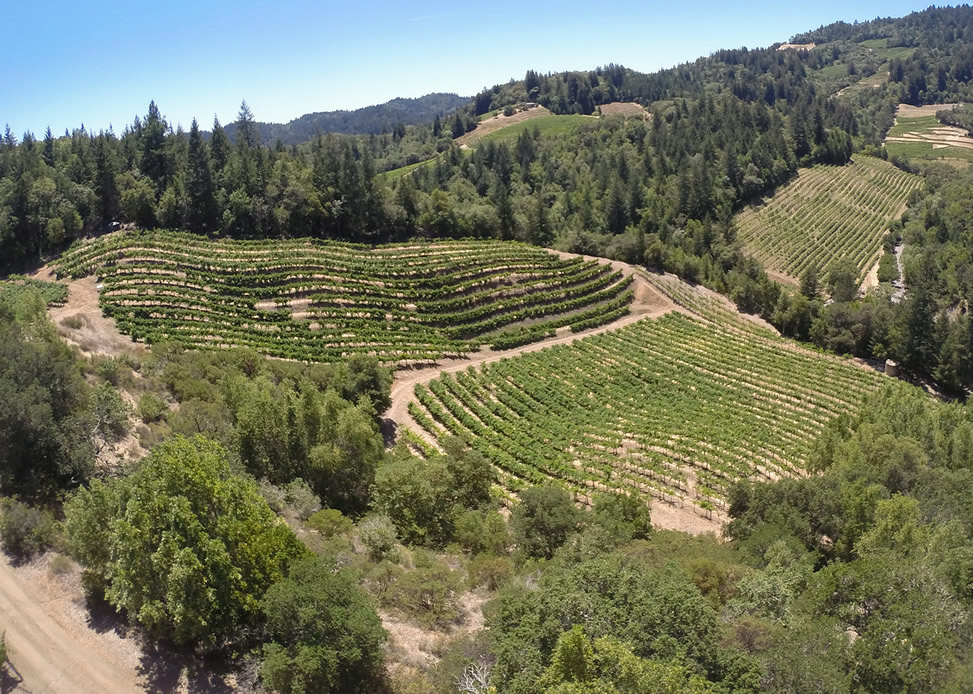

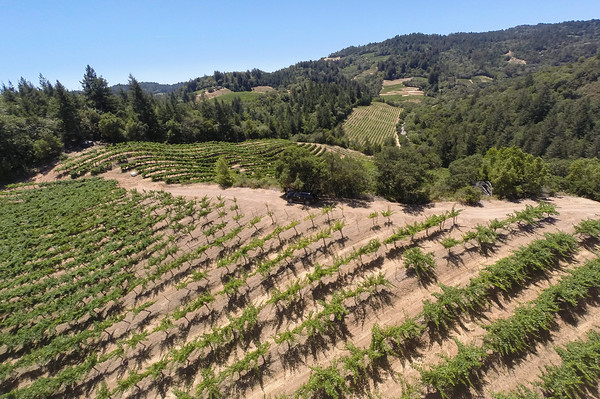
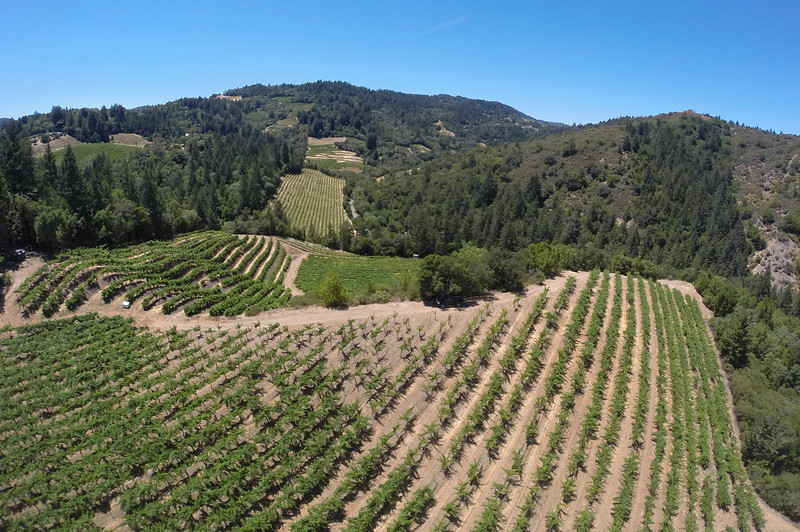
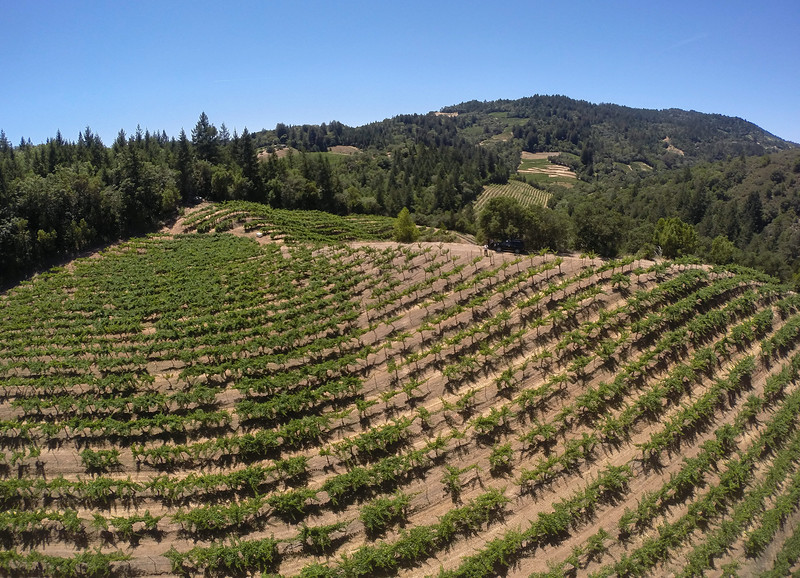
See below for cultivars by block passed down from prior management companies. We can't vouch for their correctness.
Call Mark Holler at 650-799-6571 if you are interested in this fruit.
Check out the Pulido Vineyard Management Grower's Blog for up to date info on this vineyard.
Final Yield results for 2013 were:
| Crouse Vineyards 2013 Income Report | ||||
| Buyer/Blocks | Blk.# | Acres |
Tonnage Act. |
|
| Crouse MVMV Cab.Sauv. | 3,4,6 |
9.92 | ||
| Crouse MVMV Merlot | 5M, 8 |
1.185 | ||
| Gooding Dumaine Cab. | 5Cab |
1.774 | ||
| Moyal Toulouse Merlot | 5M |
1.376 | ||
| Criste Merlot | 8 | 2.223 | ||
| Nelson Cab. Sauv. | 7 | 0.818 | ||
| Hagyard Orleans Cab. Sauv. | 6 | 1.48 | ||
| Holler Orleans Cab.Sauv. | 6 | 0.27 | ||
| Total Cab.Sauv | 5.5 | 14.262 | ||
| Total Merlot | 1.7 |
4.784 | ||
| Total Both Cab and Merlot | 7.2 |
19.046 | ||
tons/acre |
lbs/vine |
|||
| Cab Yield | 2.59 | |||
| Merlot Yield | 2.81 | |||
| Overall Yield | 2.64 | 3.97 | ||
The results above are very good. If we can reproduce these results on average the vineyard these blocks will be doing very well. The main area for imrprovement is Block 1L (Bachus) which yielded no fruit in 2013 due to pruning back to old wood after serveral years of not farming this block. This block which is ~3.1 acres has the potential to add another 8 tons of Cabernet Sauvignon fruit to the total which would be a 50% increase if it can yield 2.6 tons/acre. Historically this block has yielded poorly which is why farming it was abandoned. Our strategy is to add nitrogen aggressively until the vigor and yield reach the level we are seeking. With the reservoir leak greatly reduced there should also be a modest amount of water available for irrigation which will also be critical for improving the yield of this block.
Here is a picture of Block 6, Orleans.
Here is a picture of the 6 rows of Merlot from Decatur block (8). The vineyard in the distance with rows running horizontally in the photo is the Mount Veeder Winery Vineyard owned by Consellation Brands.
New Block Names for Reference:
Old Block Number / New Name
1 Bachus, 3 Royal, 4 Bourbon, 5cab. Dumaine, 5merlot Toulouse, 6 Orleans, 7 Duphine, 8 Decatur
10/9/13 PICKED the rest of Crouse Vineyards, 5.571 tons of Cab and 1.185 tons of Merlot from blocks 3,4 and Merlot from 8.
10/1/13 Picked 1.48 tons for Eric Hagyard from Crouse Orleans Block 6.
Eric Hagyard who works with Aaron Pott graciously shared the ETS report on his must from Crouse Orleans Block 6. Here is his comment on it: "Malic seems a bit high, but I have seen that elsewhere this year, and I would love to see a smaller Potassium, not sure how to influence that though, any ideas?" The YAN seems low at 85ppm but, he didn't seem to think so. He said everything he gets is below 125. Camalie initially had high potassium, high pH fruit when we bought it but the issue has dissipated with consistent farming and a replant. Not totally true if you believe the data above on 10/6. Not sure why the problem went away at Camalie but, I am sure that Crouse Vineyards will be receiving more consistent farming under our supervision. We definitely won't fertigate with any potassium.
10/2/13 Picked 4.349 tons of Cabernet Sauvignon from Crouse Orleans Block and a fringe of her Block 4 for Karen's program. We have harvested 12.1 tons from Crouse Vineyards thus far and expect to harvest 6-7 tons more. Sampled 60 petioles from Orleans block at Crouse Vineyard and sent to Dellavalle lab for analysis of the nutritional status of the vines. The vines are sinescing early or showing some type of nutritional deficiency. The Crouse main well ran mostly dry after giving us 230K gallons. Quite good for a Mount Veeder well. The reservoir on the other hand only provided about 50K gallons of its 300K capacity due to leakage. The vines have each received about 50 gallons which is adequate but low especially for these relatively large old vines being cropped more heavily than in the past. Their old/deep roots help them survive on less water.
Brix Data:
| Vineyard Block | 8/30/13 | 9/4/13 | |
|---|---|---|---|
| Crouse Block 3 | 21.9 Brix | ||
| Crouse Block 4 | 22.8 Brix |
||
| Crouse Block 5 Cab. | 24.7 Brix | 25.7 | |
| Crouse Block 5 Merlot | 22.8 Brix |
||
| Crouse Block 6 North | 22.5 Brix | ||
| Crouse Block 6 South | 21.5 Brix | ||
| Crouse Block 7 Cab. | 23.5 Brix | ||
| Crouse Block 8 Merlot | 23.3 Brix |
Updated Yield Estimate 8/30/13
We did a similar measurement at Crouse Vineyards in Orleans (Block 6), row 27, mid row. We counted bunches on 4 vines and got 63.56,46 and 53. The lower bunch count vines had one or half of one cordon cut off which is quite common in this block. We picked the vine with 53 bunches and removed half the clusters and weighed those 27 bunches.
4.23 oz. x 54 bunches/vine = 14.3 lbs. per vine. An eleven vine bunch count in this block earlier in the year yielded an average bunch count of 42/vine. Using that more conservative number, 4.23 oz. x 42 bunches = 11.1 lbs/vine. x 500 vines/acre in this block translates to 2.8 tons/acre. Figuring 11 lbs per vine for blocks 3,4,6 and 8 one would get
| Block | lbs/vine | vines | Tons | |
|---|---|---|---|---|
| 3 | 9 | 1350 | 6.1 | |
| 4 | 9 | 883 | 4 | |
| 6 | 11 | 1080 | 5.9 | |
| 8 (Merlot) | 11 | 663 | 3.6 | |
| Totals | 19.7 |
Yield estimation 6/14/13 in Orleans(6) and Royal(3).
Orleans(6)
Row 35 Vine 2 22 bunches
Vine 9 49 bunches
Vine 10 Pierce's disease one arm
Vine 16 52 bunches
Vine 21 40 bunches
Row 16 Vine 4 41 bunches
Vine 20 49 bunches
Vine 43 44 bunches
Vine 67 arm missing
Vine 68 39 bunches
Row 25 Vine 15 41 bunches
Average 41.8 bunches x 1/3 lb./bunch = 13.9 lbs/vine x 500 vines/acre = 3.5 tons/acre. x 2.15 acres = 7.5 tons.
Royal(3)
Row 8 Vine 8 63 bunches This is one old + one younger vine together
Vine 36 48 bunches
Average 55 bunches x 1/3 lb/bunch = 18.5 lbs/vine pair x 530 vine pairs/acre = 4.9 tons/acre x 1.36 acres = 6.6 tons
If Block 4 Bourbon yields similarly x .83 acres = 4.0 tons
This estimate shows 18 tons of fruit from just blocks 3,4 and 6.
This estimate needs to be modified by several factors, first is vine count which needs to be reduced by around 10% for missing vines.
It also needs to be reduced for the crop selection that will take place to improve quality via uniformity. This could cut the yield by 10-50% depending on how selective you and Jeff want to be. One can always trade yield for quality but, you have to have good yield. That's what we have this year.
Soils Report Napa County Survey 1978
Bloom observed 20% in block 6 near top of knoll 5/4/13.
Fertigations were done 4/15-4/17/13. Calcint 15-0-0 fertilizer was used as a source of Nitrogen with no impact on the soil acidity.
| Block | # of Vines | oz./vine | |
| B1 | 1500 | 2 | |
| B3 | 1350 | 1.5 | |
| B4 | 883 | 1 | |
| B5 Cab | 300 | 1 | |
| B5 Merlot | 360 | 1 | |
| B6 | 1080 | 1 | |
| B7 Cab | 395 | 2 | |
| B8 Merlot | 663 | 1 | |
Brix measurement 9/27/12 8:00am Block 5 rows 35,36 Cab.Sauv. 25.0 Brix.
Brix measurements 9/24/12 same site in Block 3 as below 22.8 Brix, Merlot sample from the top of block 8 == 23.7Brix
Brix measurement 9/12/12 same site in Block 3 as below. 20.6Brix.
Brix measurement 8/30/12 from Block 3 rows 7 and 8, new and old vines, 30 berry sample: 18.7 Brix
The 2012 Petiole analysis at veraison, 8/8/12.
We are applying Magnesium Nitrate and Magnesium Oxide to address the issues above. Boron and Zinc sprays will be worthwhile next spring pre bloom.
Below is a schematic map of valve locations where the irrigation blocks correspond to the blocks above. This map was prepared by Luis.

The above map was found to have exact row counts and valve locations in all cases for the upper blocks by M.H. Block sizes are not to scale. M.H. has a marked up version of this map with selected row vine counts and spacings. See his irrigation log book.
| Irr. Block | Vine x Row Spacing | Vine Positions | Live Vines Estimate |
Cultivar | Acres | Vines/ acre | Expected Irr. Flow | Actual Irr. Flow | Head Pressure to Irrigate | MgNO3 +MgO Fert. 11%N,9%Mg 8/25-30/12 | Irrigation Volume, Gallons/vine 8/25-8/30/12 | Irrigation Volume, Gallons/vine 9/8-9/14/12 | Irrigation Volume, Gallons/vine 9/24-9/27/12 | Irrigation Strategy using only upper well |
|---|---|---|---|---|---|---|---|---|---|---|---|---|---|---|
| 1L | ~8x12 | 1350 | 1350 C.S. on 1103P | ~3.1 | ~435 | Dry Farm w/2-fertigations | ||||||||
| 1U | ~8x12 | 990 | 990 C.S. on 110R |
~2.3 | ~435 | Dry Farm | ||||||||
| 3 | 8x12 and 6x12 Double planted | 1350 | 1282 | 1350 C.S. | 1.36 | 1060 | 11.2 gpm | 26 gpm with 4 | 70 psi | 1.2 oz/vine | 4.4 gallon/vine | 2.6gpv | 2.5 gpv | Use booster pump and do with Blk.4 |
| 4 | 8x12 and 6x12 Double planted | 883 | 838 | 883 C.S. | .83 | 1060 | 10 gpm | 26 gpm with 3 | 70 psi | 1.2 oz/vine | 4.4 gallon/vine | 2.6 gpv | 2.5 gpv | Use booster pump and do with Blk. 3 |
| 5 | 8x8-9 | 660 | 523 | 300 C.S 360 Merlot |
.49 .59 |
605 | 3.2 gpm 4.8gpm |
3.2 gpm 4.8 gpm |
103 psi 100 psi |
1.28 oz/vine | 3.8 gallon/vine | 5.5 gpv 10.0 gpv |
5.0 gpv, 6.0gpv |
Do rows 32-35 first (333 vines) then 36-42 (323 vines) |
| 6 | 8x8(304 vines), 8x12(775 vines) | 1080 | 1080 C.S. | 2.15 | 502 | 9 gpm | 6+7.2 gpm | 93 psi | 2.2 oz/vine | 4.1 gallon/vine | 4.6 gpv | 4.2 gpv,6.5 gpv | Do rows 16-25 first then 1-15+26-31 | |
| 7 | 6x12 | 395 | 395 C.S. | .65 | 605 | 3.3 gpm | 6.7 gpm | 95 psi | 4.0 oz/vine | 8.1 gallon/vine | 4.8 gpv | 8.5 gpv | Whole Block at once | |
| 8 | 6x12 | 663 | 663 Merlot | 1.1 | 605 | 5.5 gpm | 7.6 gpm | 93 psi | 1.8 oz/vine | 11.5 gallon/vine | 6.8 gpv | 0,well dry. | Do all at once. Check for leaks at bottom | |
| Totals | 5025 | 5025 | 7.17 | 715 | 44.4 gpm | 29K gallons | 22K gallons | 18K gallons |
Cab acreage 3,4,5C,6,7 = 5.5 acres + 1L =9.1 acres
Merlot acreage 5M, 8, = 1.7 acres
Chradonnay vines in 1U row 26 = 61
Pinot Noir Vines in 1U rows 24-25 = 108
Notes: The above numbers were estimated 8/28-9/27/12 by M.H. They are approximate in that not every vine was counted. Typically two rows per block were counted and a geometrical approximation was made. Row counts were exact and actual row and vine spacings were measured however, much of the vineyard is on steep hillsides and the row spacings vary significantly. Fertigation and Irrigation volumes are approximate as some occurred without full flow to blocks as the system was being characterized. 20% Merlot overall. 3-8% of vines missing in blocks 3 an 4. Approximately 20 % of vines in Block 5 missing.
Block 1L vines were counted by M.H. 5/1/14. Total count 1350. See notebook for vine counts by row. The full rows are 126-130 vines long. 15 rows total but only 9 rows have no gap in the middle. Only 2-3% missing vines including vine locations in the mid block slide were found in this block. Some significant deer damage mid block at this time.
Irrigation notes: In Spring 2013 a 5000 gallon tank was added at the top of the vineyard and the irrigation system was converted to gravity feed. A 2" water meter with eKo Pro monitoring was added to the reservoir pump line. Characterization of the reservoir pump indicates that its pump rate is 35 gpm when pumping at 110psi to the tank. An eKo Pro monitor of the tank level was also installed. It was demonstrated that the flow from the new tank is sufficient to irrigate blocks 6,7,8 together at one time which means it can supply at least 25 gpm.
Only the upper well has enough pressure to irrigate the upper blocks 5-8. Its flow is 4gpm to 7gpm depending on the height of the block and how many row valves are open. The booster pump is only capable of pumping at up to 85 psi due to wear or damage from being run dry. It is capable of very high flow rate 150gpm at low back pressures. Higher flow rates were tested to see if higher pressure could be achieved but, with no success. The pump should be rebuilt or replaced to enable more rapid irrigation of the vineyard and to enable water from the lower well to be used on the upper blocks. The pump is made by Grundefos. The motor and bearings seem to be in good shape.
Several attempts were made to use the lower well to irrigate the upper blocks. The lower well demonstrated good flow, 10 gpm at pressure as high as 105 psi but faded and then shut down after about 20 minutes. Apparently some current protector in the pump motor is shutting down the pump to protect it from permanent damage. On two occasions the pump protector unit at the well head shut down the well. The tripped light was lit red in these instances. It should not be used for irrigating the upper blocks or permanent damage can be expected. On 8/31 as we were filling the half empty tank for a prolonged period of time from the old well the pump protector tripped again. This trip at relatively low back pressure, at most 5psi, suggests that the pump in this well may be nearing end of life. It's only use in this state is to top the tank to replace the tenant's consumption which should normally take less than 20 minutes.
Block 7 and 8 are very steep with a drop of almost 200 ft. from the top to bottom of some rows especially the norther most. It is important to monitor for hose blowouts at the bottom of these blocks. Inside couplers were used to replace outside couplers with success but, a better solution would be to put inline pressure reducers mid block in the hoses of these blocks.
Block 3 and the western part of block 5 are on volcanic tufa interspersed with shale gravel/rock. The rest of the vineyard is on greyish lavender soils mostly gravelly.
After three irrigation sets totalling 110K gallons over 5 weeks the new well ran dry or dropped to about 2 gpm residual flow. We now know the total volume of this well.
The water meter on the line from the two wells indicates 1.57 million gallons as of 9/27/12 for an unknown time period we now believe to be at least 6 years. The new well appears to hold about 110K gallons and a reasonable guess for the older well would be that it holds something similar. If so then the total available well volume would be 220K gallons which would take 7 years to pump out. 220K gallons/5000 vines = 44 gallons/vine. This water meter does not include the volume of water pumped from the reservoir which is on the order of 1/2 acre ft. = 160k gallons which would correspond to another 32 gallons/vine. The total best estimate of available water is thus 76 gallons/vine which is adequate for the 5000 vines of blocks 3-8 but, not enough to irrigate blocks 1 and 2 as well without extreme conservation measures such as sub surface drip and precision irrigation based on soil moisture and leaf water potential data.
In a conversation 9/27/12 with Bert from Dave Bess Well and Pump he told me that the upper well is about 200 ft. deep with the pump at 180ft. he thought.
As of 9/27/12 both wells are down to about 2 gpm flow rates. It appears that the pump in the old well and the pump protector on it are working fine. The old well is being used to fill the water tank for Ed.
6/5/13 Ray Bertolucci came out and tested the old well. He measured the water level in the well with a conductivity tester as we pumped it down. The well had been resting for several weeks before this testing. Ed's water had been supplied by the new well. The meter reading at test start was 1625630. The ground water level in the casing at the start of the test was only 56 ft. down. The well pump ran steadily for about 30 minutes before the water level was pumped down to the level of the pump which we found to be 260 ft. down. We were able to tell that there were intake vents in the side of the casing around 170 ft. The delay between pumpings was set for 12 minutes but was increased to 30 minutes to give the well more time to recover between pumpings. The well pump automatically shuts off immediately when it runs dry based on sensing current flow through the pump motor. Conclusion again is that the well pump is fine. It was a surprise that there is over 200 ft. of ground water level above the pump. This is encouraging. The meter reading at the end of the test was 1625930 indicating we pumped about 300 gallons of water out of the casing during this test. Ray indicated that the well has an 8gpm restrictor in it that is making all of the noise. It was put in to throttle the pump rate to the recovery rate at one time but, the recovery rate is now down to 2.5gpm so it no longer serves any purpose. It makes the well pump work harder and draw more current and should be removed.
6/6/13-14 Installed DIG electric timer controled valves on blocks 3,4,6,8. Working well.
Spring 2015 added a reverse bilge pump to recover water leaking through the dam to a sump below the dam. As of 7/8/15 the pump has put 372400 gallons back into the reservoir. Total use from the reservoir thus far in 2015 is only 58000 gallons. The pump in the reservoir failed 7/8/15 with the reservoir roughly 30-40% full.
7/8/15 Below is a summary of water user for each source for 2013 and 2014.
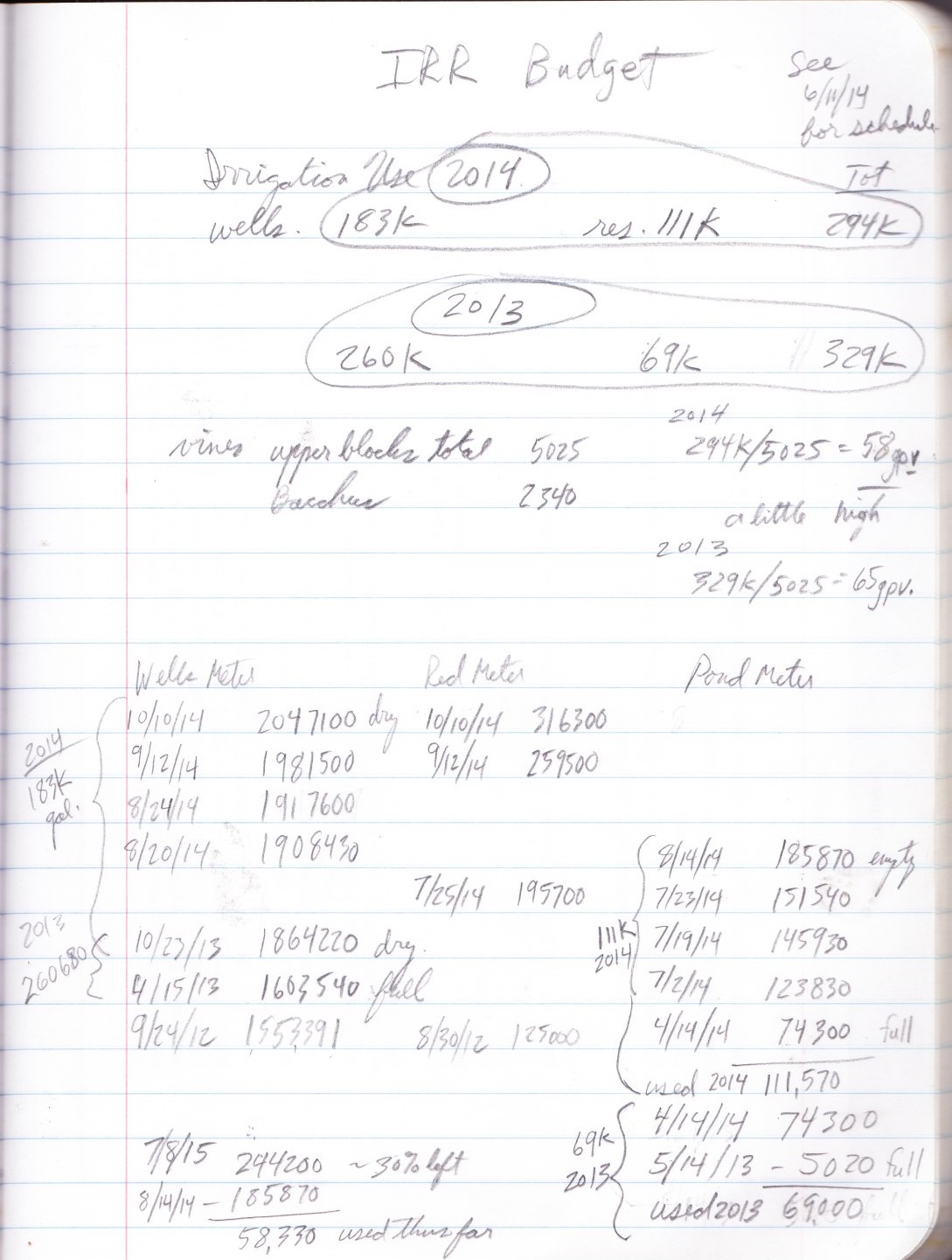

Mount Veeder Magic Vineyards makes its own wine from these grapes and sells it by the barrel. This is your chance to access some of the planet's best grapes.
The map below is newer but still contains errors, omissions and inconsistencies.

The data in the table on the above map has many numerical errors in the estimate of M.H. . See the irrigators' Data below for his best estimate. Blocks 3 and 4 were interplanted some time later with a separate set of vines on closer 6' spacings. It is unlikely that these newer vines were the same cultivar as the older vines. Their age is unknown.
Below is an old blocking description of the vineyard which is no longer in use. It has a number of errors in it but, is sometimes valuable when doing detective work.
| Mount Veeder Magic Vineyards | 1801 Mount Veeder Road | ||||
| 866.750.2091 phone/fax | |||||
| varietals: | # acres | ||||
| Cabernet Sauvignon | 13.8 | ||||
| Merlot | 1.92 | ||||
| Total acres | 15.72 | ||||
| Block Detail | |||||
| Varietal | # acres | # vines |
Notes | ||
| Block 1 | Cabernet Sauvignon | 7.3 | 3,269 |
Clone 337 on 1103P rootstock on lower portion and 110R on upper. replant ~2002 | |
| Block 2 | Cabernet Sauvignon | 1 | 570 |
Clone 337 on 101-14 rootstock. | |
| Block 3 | Cabernet Sauvignon | 2.5 | 1,300 |
Clone 337 on 110R rootstock. | |
| Block 4 | Cabernet Sauvignon | 3 | 1,830 |
Clone 7-8 on 3309 rootstock. | |
| Block 5 | Merlot | 1.33 | 600 |
Mt. Veeder clone on St. George rootstock. | |
| Block 6 | Merlot | 0.59 | 364 |
mt. Veeder clone on 5C or SO4 rootstock. | |
| Block 7 | Cabernet Sauvignon | .72 | |||
| Block 8 | Merlot | .72 | |||
| Totals | 15.72 | 7,933 |
|||
* The numbers in the table above are not exact and may contain errors. This is for general reference only.
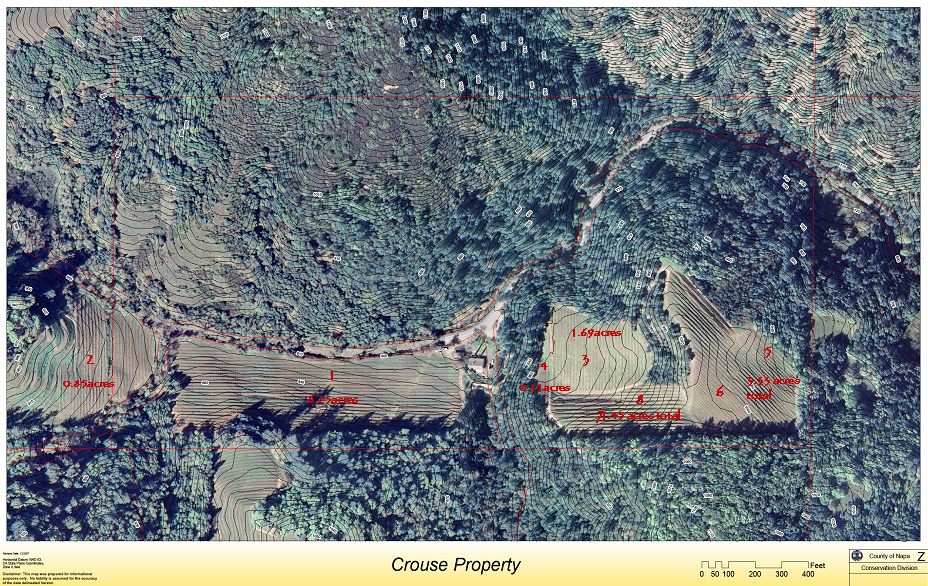
Aerial image below taken early season June 17, 2010
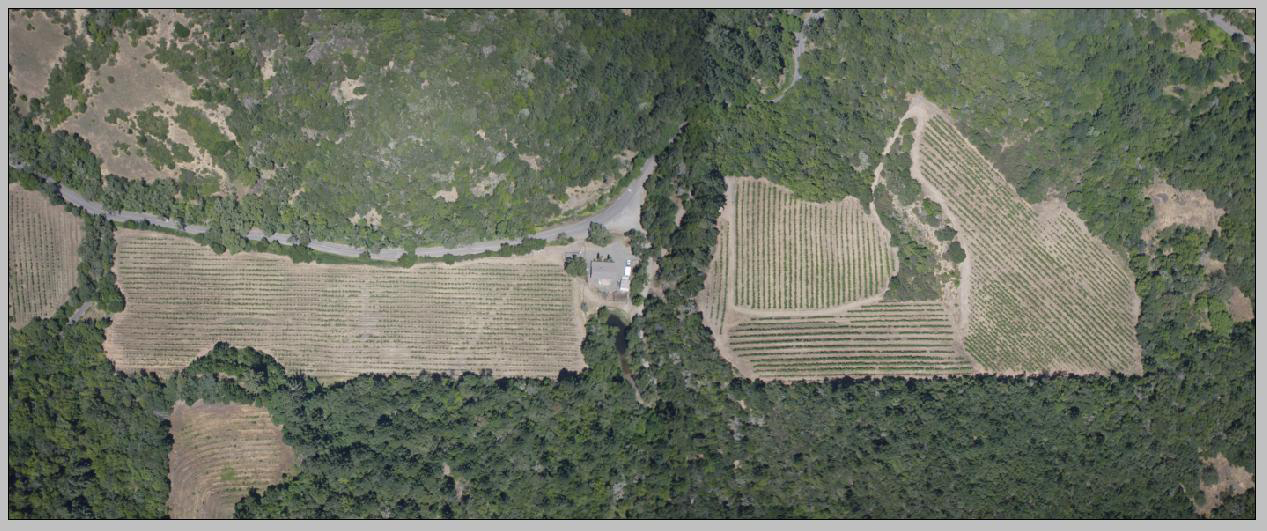
Here is a closer view of the upper vineyards.
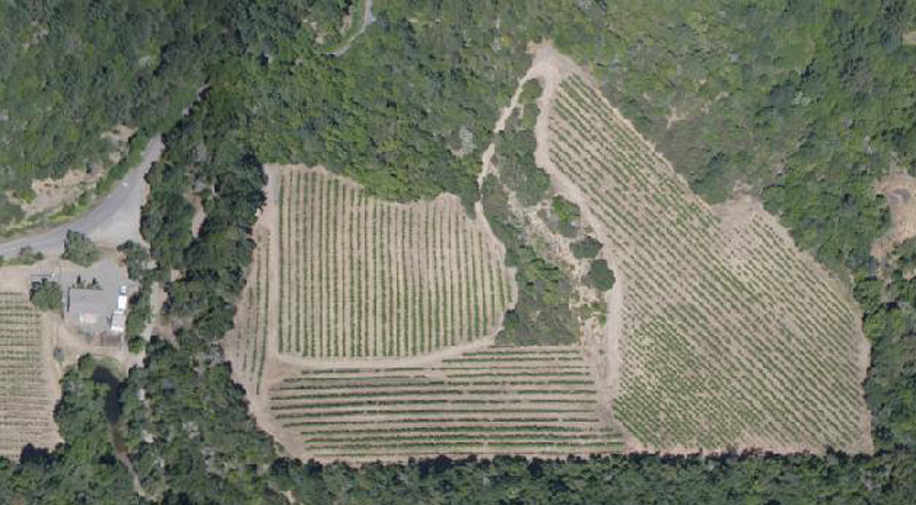
The design below has been implemented and is being used as of 8/25/12 for irrigation and fertigation successfully. It is capable of supporting 105psi at the manifold pad. The upper well operating pressure at the well head to irrigate block 5 is 50-55psi. while the pressure at the lower manifold is 95 psi. The upper well flow is throttled by partial closure of a valve on the outflow of the well to produce backpressure needed by the pump protector to properly control and protect the well. The protector is doing some kind of control which causes the pressure at the well head to oscillate between 50 and 55psi with a 5 second period roughly.
A pressure releif valve set at 110psi, a pressure gauge, and a water meter were also added to this bypass link. Both the pressure sensor and water meter are connected to an eKo Pro node at the pad and are sending data every 15 minutes. Note that the 2" check valve in the booster pump line has failed. This circuit needs to be manually shut off at one or both of the valves in the circuit to prevent fertilizer from flowing back to the tank until the check valve can be repaired. Care was taken during the most recent fertigations to prevent such back flow from happening. Untrained personnel should not fertigate using this system before the valve is replaced.
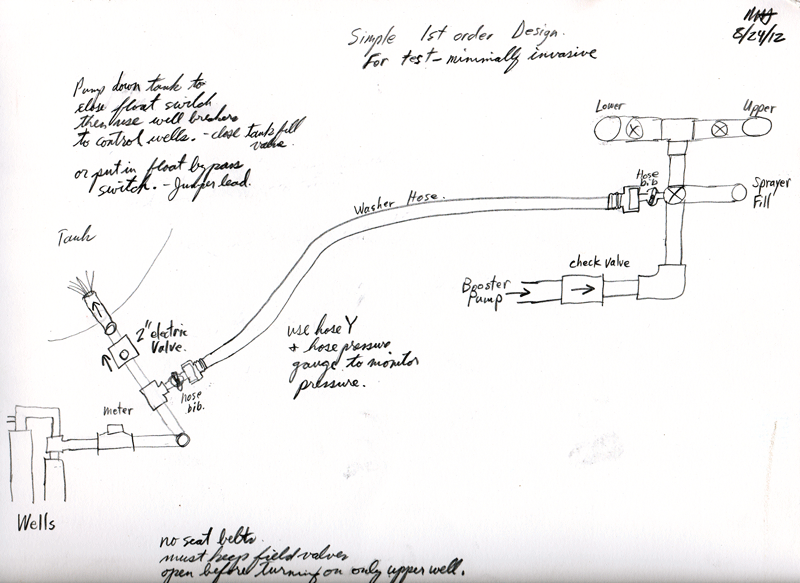
9/2/12 Below you can see all of the soil moisture data for the last 6 weeks including the results of the most recent irrigations/fertigations. The manifold pressure and water meter cumulative volume are also evident. You can see that we applied roughly 53k gallons since week 36.
This graph shows the 3 1/2 weeks in July and August during which limited water got to vines.

Below is a plot of soil moistures for the vineyard in 2011. The vines were watered on a regular 7-10 day schedule in August. There was a 12 day gap from 9/2 to 9/14 during which more drying occurred. On 10/4/11 the heavy rain pre harvest took place. Blocks 7 and 8 did not appear to get much water but, there was an issue of sensor placement relative to the drippers which was corrected in 2012.

Yield 2012. Not sure where the per block numbers came from in the table below. In 2012 the vineyard was farmed by Truchard.
| Irr. Block | Vine x Row Spacing | Vine Positions | Live Vines Estimate |
Cultivar | Acres | Vines/ acre | XT | Xp | lbs/vine | |
|---|---|---|---|---|---|---|---|---|---|---|
| 3 | 8x12 and 6x12 Double planted | 1350 | 1282 | 1350 C.S. | 1.36 | 1060 | 1.745 | 3490 | 2.58 | low? |
| 4 | 8x12 and 6x12 Double planted | 883 | 838 | 883 C.S. | .83 | 1060 | 1.285 | 2570 | 2.91 | low? |
| 5 | 8x8-9 | 660 | 523 | 300 C.S 360 Merlot |
.49 .59 |
605 | 1.205 1.172 |
2410 2345 |
8.03 6.51 |
high?
|
| 6 | 8x8(304 vines), 8x12(775 vines) | 1080 | 1080 C.S. | 2.15 | 502 | 3.216 | 6433 | 5.95 | high? | |
| 7 | 6x12 | 395 | 395 C.S. | .65 | 605 | .437 | 875 | 2.21 | ||
| 8 | 6x12 | 663 | 663 Merlot | 1.1 | 605 | 2.177 | 4355 | 6.56 | ||
| Totals | 5025 | 5025 | 7.17 | 715 | 7.88CS 3.35M |
Total fruit 2012, 7.88 tons C.S. 3.35 tons Merlot, Merlot to Cab Sauv. ratio 30%/70%.
Weigh Certificates from Karen Crouse. Data extracted from original documents by M.Holler 11/11/12
10/6/9 Cab. Sauv. 6.27 tons
10/9/9 Cab. Sauv. 2.43 tons
11/8/09 Cab. Sauv. 2.45 tons
Total for 2009 Cab. Sauv. 11.15 tons. Seems high for Cab only and since no weigh tags for Merlot it is reasonable to assume one of these tags is for Merlot.
10/21/10 Cabernet Sauvignon 4.15 tons + 1 ton sold separately = 5.15 tons
10/21/10 Merlot 1.297 tons + ¼ ton sold separately = 1.52 tons.
Total for 2010 6.67 tons. = (5.15 tons C.S., 1.52 tons Merlot), Merlot to Cab Ratio 23%Merlot/76% Cab. About right.
It looks like 2009 was identical to 2012 in total tonnage but, there was no weigh certificate for Merlot in 2009. I have to assume that one of the 2.4 tons loads was Merlot which would be 21% of the total, about what I would expect from the other year’s data.
2010 was not a good year for you or any of us for that matter with the yield off 40%. I imagine your 2011 crop was similar if not worse based on how James and I fared in that year.
Bud Break 2013, Raw Photos at full resolution for download and marketing use.
ETS Reports
July 2012 ETS 2010CabBlendwine

Last Updated 9/11/14 Mark Holler, Pulido Vineyard Management 650-799-6571